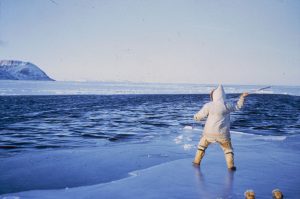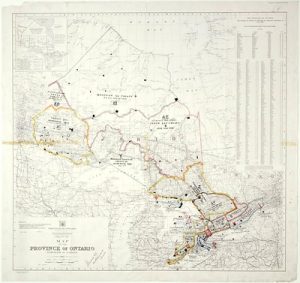Treaties
Warm up

In partners or small groups ask each the following questions:
- Describe the place you grew up in.
- How do you feel about this place?
- Do most of the people stay in that area? Why or why not?
- What do you think a land agreement is?
- Do you have any land agreements in your first country? If so, explain.
Vocabulary Preview
Match the word with the definition. If you are not sure, look up the word in the dictionary [new tab]
Vocabulary Review – Text version
Match the terms provided with their definition below.
Terms:
- sacred
- territory
- proclamation
- treaty
- constituents
- negotiate
- reserve/reservation
- diverse
- colonization
- inhabit
- descend
Definitions
- very different from each other
- a formal written agreement between 2 countries or governments
- an official announcement about something that is important –
- greatly respected
- land that is owned by a particular group
- to discuss an issue and come to an agreement between 2 sides
- to move from a higher level to a lower one
- the act of taking over another country or area and sending citizens to settle there
- to live in a place
- someone who votes in a specific area
- an area of land kept separate for Indigenous peoples to live –
Check your Answers in Footnote[1]
Practice the new vocabulary by asking and answering the following questions with a partner. Make sure to use the new vocabulary word in your answer.
- Do you think this elective class is very diverse? Why or why not?
- Does your country of origin have any land treaties that you know of? Explain.
- Where is a place that is sacred to you?
- Have you ever had to negotiate with a company or salesperson about what you wanted? Explain.
- Are there Indigenous reservations in your country of origin? If yes, describe them.
- Where do most Georgian College students inhabit the area?
- Has colonization ever taken place in the history of your country of origin?
- Does your native country’s government ever give out proclamations? If yes, about what?
- What time of year do tourists usually descend into your hometown?
Activity source: Vocabulary Preview – Treaties by Virginia McHardy is licensed under CC BY-NC 4.0
Treaties and The Indian Act

In your previous lesson, you learned a bit about the culture and way of life of many diverse Indigenous nations before the Europeans came to North America. At that time there were several distinct groups including First Nations, Métis, and Inuit peoples who had their own traditions and languages. They lived for thousands of years using the land to hunt, fish and gather food. Indigenous peoples set up their own political and social systems and had a deep respect for the land they lived on.
When the Europeans descended on North America, both the British and the French were very excited to settle in Canada because of its rich land and resources. The British and the French fought over different parts of what became Canada even though the Indigenous peoples had been living on the land for a very long time. The British eventually won out and in 1763 King George III issued a Royal Proclamation which stated that Indigenous people had the right to continue to live on the land and use its resources. At that time, an equal partnership was supposed to be established between the British government and the diverse Indigenous nations which included negotiating where Europeans could live. An agreement was made between the 2 parties which established that the newcomers could not take away land from the Indigenous people or buy it directly from them. This meant that arrangements would be made where specific sacred land could not be bought and in some areas Indigenous people could still hunt or fish in the areas that they sold. These individual agreements were called treaties. Sometimes the treaties were signed and sometimes they weren’t. Therefore, a lot of the time, Indigenous people never got paid for their land.
Things changed quickly though. In 1867, the Dominion of Canada was formed and the British government no longer had power over the people living there. For the next 50 years, Canada made a number of treaties to claim land and basically take over areas that were inhabited by Indigenous nations. This was the start of colonization. The Canadian government allowed its constituents to settle in the majority of the land by forming treaties and taking over areas like northern Ontario, Manitoba, Saskatchewan, Alberta, British Columbia, Yukon and much of the Northwest Territories.
To this day, Indigenous communities and the Canadian government have had different understanding of what treaties meant. Canadian settlers were using up the rich resources on the land and so the Indigenous population thought that a treaty would help protect their way of life. In fact, treaties were used by the government to develop these lands which they deemed as surrendered. In contrast, reserves were created to remove Indigenous people from these areas and have them settle in places with little or no resources. Many of these reservations are in existence all over Canada today and still lacking resources.
This reading piece was inspired by the following resources:
Yellowhorn, E., & Lowinger, K. (2017, September 12). Turtle Island: The story of North America’s First People. Annick Press
Government of Canada. (2017, May 2). First Nations in Canada. https://www.rcaanc-cirnac.gc.ca/eng/1307460755710/1536862806124
Historica Canada. (n.d.).Treaties in Canada information guide. http://education.historicacanada.ca/files/31/Treaties_English.pdf
LISTN. (n.d.). First Peoples: Learning materials for newcomers. https://listn.tutela.ca/resources/resources-for-teachers/listn-resources/first-peoples-learning-materials-for-newcomers.html
Comprehension Questions
From the reading, answer the following questions in your own words:
- What was life like for Indigenous peoples before the arrival of the Europeans?
- Why did the Europeans want to settle in Canada?
- What was King George III Royal Proclamation about?
- Was the Proclamation followed? Explain.
- What happened in 1867?
- What areas did Canadians take over?
- In what ways were the treaties understood differently?
- What are problems do Indigenous reserves face today?
Watch Heritage Minutes: Naskumituwin (Treaty) (1 min) on YouTube
Video source: Historica Canada. (2016, June 21). Heritage Minutes: Naskumituwin (Treaty). YouTube. https://youtu.be/mVVD9yYCKiI
Discussion Questions
- Why would the land be important to Indigenous peoples?
- Why would the land be important for the British?
- Do Indigenous people have the right to be angry? Why or why not?
- Who should own this land today?
Listening Practice
Before you watch and listen to the video, answer these questions:
- On Google maps, look up where Manitoulin Island in Ontario is located.
- Brenda Collins is going to introduce herself in her mother’s tongue. Her mother was Odawa from the Sheshegwaning First Nation reserve. What do you think “mother’s tongue” means?
- Who are the Métis? Look it up in a dictionary site.
- Find out what a “Wampum belt” is.
Video source: ONgov. (2020, November 2). Brenda Collins, Knowledge Keeper and artist, Treaty 94, on What is a Wampum belt? [Video]. YouTube. https://youtu.be/fSJKuw5oNkA
Listening practice review – Text version
- What do treaties help Brenda to understand?
- how much shells cost
- how much precious time she has lost
- how much precious culture she has lost
- how much land needs to be divided
- How long did Brenda’s great grandfather talk about the 1764 Niagara treaty on one Wampum belt?
- 14 weeks
- 14 minutes
- 14 hours
- 14 days
- Brenda believes that it doesn’t matter if treaties were made 400 years ago, they should still be honoured today.
- True
- False
- Complete the phrase below by matching the words to the correct blanks. Words: moose, elk or deer, sinew, banana strings, blue, purple.
Phrase: Wampum belts were made of _______[Blank A], _______[Blank B] hide and white and _______[Blank c], shells. - What do the 2 row Wampum belt from 1613 represent?
- The white strips represent the European vessel and Indigenous canoe, while the brown strips represent the water or river. It also means the two groups should live side by side respecting each others cultures, traditions and languages.
- The brown strips represent the European vessel and Indigenous canoe, while the white strips represent the water or river. It also means the two groups should live apart and not have anything to do with each other.
- The brown strips represent the European vessel and Indigenous canoe, while the white strips represent the water or river. It also means the two groups should live side by side respecting each others cultures, traditions and languages.
- The Wampum belt today means to live in balance.
- True
- False
- Fill in the missing words in the phrase: _____ [Blank A] what you _____ [Blank B], _____ [Blank C] some for others, and don’t _____ [Blank D] to _____ [Blank E] before you leave.
- Are we ever too old to learn about treaties?
- No
- Yes
Check your Answers in Footnote[2]
Activity source: Listening Practice Review – Treaties by Virginia McHardy is licensed under CC BY-NC 4.0
Assignment/Homework

Local First Nation Reserves
A. Learn more about the First Nations reserves that are located near your city using the Ontario First Nations Maps or Whose Land and find the answer to some of these questions:
- How many reserves are there in your area?
- Which Indigenous nations live on these reserves?
- What are the populations of these nations?
- What languages do they speak?
- Have any of these nations signed a treaty or agreement in principle?
B. Go to the Videos: Indigenous voices on treaties webpage (new tab) and choose a video (besides the Brenda Collins one) to watch on “Indigenous Voices on Treaties” . Write a reflection on the video you watched by answering the questions:
- How did treaties affect the person in the video?
- How did the video affect you and your way of thinking? Can you relate in any way to the speaker?
Attribution
Except where otherwise noted, Treaties by Virginia McHardy is licensed under CC BY-NC 4.0.

